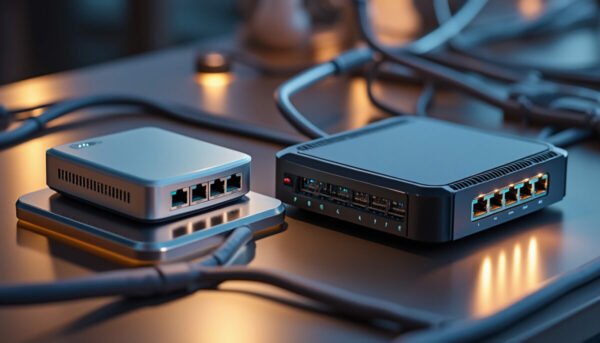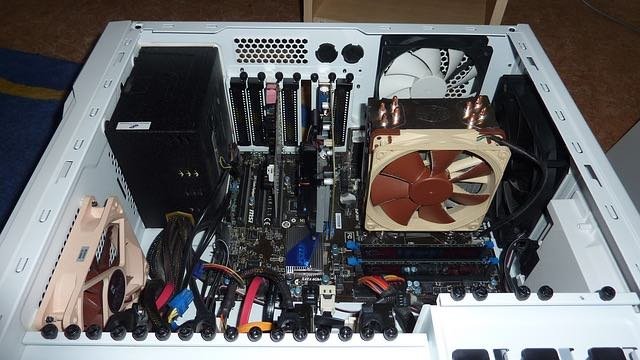Hub and switch: essential difference to know to optimize your network
IT connectivity relies on essential devices such as hubs and switches, which play a crucial role in data management within Ethernet networks. Understanding the differences between these two devices can significantly improve the efficiency and performance of your network infrastructure. This article will explore the features, advantages, and disadvantages of each device, providing a detailed overview to optimize your network.

Understanding of networks and connected devices
Before delving into the details of hubs and switches, it’s important to understand the general context of computer networks. Networks are sets of interconnected devices that share resources and information. In a typical network, each device is often connected to the internet via a router, which also acts as the main access point. Devices such as computers, printers, and servers interact via Ethernet cables with RJ-45 connectors.
Hubs and switches are commonly used to establish this connectivity. Hubs, considered older and more basic, transmit data to all connected devices indiscriminately. Switches, on the other hand, are more modern and optimize data distribution by sending it only to the intended recipients. Understanding this distinction is essential for effective network management.
The options available on the market include well-known brands such as Cisco, D-Link, and TP-Link, which offer various models tailored to the needs of users, whether private or professional.
What is a hub in a computer network?
A hub is a network device essential for communication between different devices on the same network. It works primarily by receiving data from one connected device and redistributing it to all other devices. This broadcasting process is analogous to a radio broadcasting a signal on a specific frequency: everyone receives the same message, whether it’s relevant or not.
How a hub works
In the case of a hub, when a computer sends a data frame, the device doesn’t know where to direct that data. So it resends it out to every port except the one it was received on. This means that all machines connected to the hub receive the same message, which can cause network congestion.
The main disadvantages of a hub include:
- Bandwidth shared between all connected devices.
- Frequent data collisions, because multiple devices may attempt to send data at the same time.
- Limited security, as all data sent is accessible to all devices.
Hubs were once commonly used in local area networks, but their popularity declined as more efficient solutions, such as switches, became available.
Examples of popular hubs
Hubs are often simple devices with no advanced configuration required. Brands like Linksys and Netgear have historically offered affordable and easy-to-use hub models. However, interest in hubs has largely declined with the emergence of more powerful switches. Today, basic hubs are still found in very specific applications or for temporary installations.
Definition and role of a switch in a network
A switch is a smart network device that connects multiple Ethernet devices. Unlike hubs, switches are able to manage data much more efficiently. They redirect frames based on each device’s MAC address, thus optimizing the flow of information across the network.
How a switch works
When a switch receives a data frame, it consults its MAC address table to determine which port to send the data to. This mechanism enables targeted broadcasting, minimizing wasted bandwidth and reducing collisions. Modern switches also use store-and-forward architectures, which means they can temporarily store frames before sending them to the correct recipient.
The benefits of a switch include:
- Sending data only to the necessary devices maximizes efficiency.
- Reducing collisions improves network performance.
- Features such as VLAN management allow network segmentation to enhance security.
Examples of popular switches
Switches are available in a variety of models, suited to various needs. Brands like Cisco, MikroTik, and TRENDnet offer managed and unmanaged switch options, providing flexibility depending on user requirements.
Technical comparison between hubs and switches
To understand the fundamental differences between a hub and a switch, it’s essential to examine several technical aspects. This includes how they work within the OSI model, their data management capabilities, and their impact on network performance.
| Criteria | Hub | Switch |
| OSI layer | Layer 1 (Physical) | Layer 2 (Data Link) and sometimes Layer 3 (Network) |
| Data management | Broadcast to all ports | Send only to target ports |
| Collisions | Frequent due to diffusion | Minimized through MAC address management |
| Configuration | No advanced configuration | Can be managed and configurable |
The data shown in this table not only reveals a stark contrast between the two devices, but also the evolution of network standards and technologies. It’s undeniable that switches, with their technical advancements, far outperform hubs in terms of performance and versatility.
Advantages and disadvantages of hubs and switches
The decision to choose a hub or switch often depends on a network’s specific needs. Identifying the pros and cons of each device is crucial to making an informed choice.
Hubs
Benefits :
- Often lower initial cost, making them attractive for small installations.
- Ease of use with no configuration required.
Disadvantages:
- Limited performance due to data streaming.
- High risk of collisions, leading to network congestion.
- Poor security, as all data is accessible to all devices.
Switches
Benefits :
- Increased efficiency by sending targeted data.
- Ability to optimize bandwidth and reduce collisions.
- Advanced features for network management and security.
Disadvantages:
- Higher initial cost compared to hubs.
- Potential configuration complexity for managed switches.
It is therefore essential to assess the specific needs of a network before choosing between a hub and a switch. For small, low-traffic networks, a hub may seem adequate, but for more complex and busy networks, a switch is often the best solution.
The importance of standards and regulations
In 2025, compliance with cabling and data transfer standards is crucial. Standards such as Gigabit Ethernet have asserted their dominance in the industry. Using hubs at this time means not fully leveraging the capabilities of modern networks. Switches, on the other hand, integrate these standards and offer superior reliability for everyday applications.
Network equipment must also meet increased security requirements to protect sensitive information and comply with data regulations. Switches, with their advanced capabilities, offer security options like encryption and access management, which are essential for today’s businesses.
New trends in switching
Technological advances have led to the emergence of new types of switches, such as Layer 3 switches, which include routing capabilities. These devices represent a significant advancement and are ideal for integrating large-scale networks. At the same time, network virtualization has paved the way for even more complex solutions, improving the flexibility and scalability of infrastructures.
Businesses are increasingly investing in networking equipment that meets growing bandwidth, security, and data management needs. Brands like Cisco and Zyxel offer switches equipped with advanced IP technologies, suitable for businesses of all sizes.
Final Considerations on Modern Switches
Many current switches also include remote management features, simplifying network administration for both small businesses and multinational organizations. This makes their deployment more convenient and maintenance less cumbersome.
FAQ about hubs and switches
What are the main differences between a hub and a switch?
A hub broadcasts data to all connected devices, while a switch sends data only to the intended recipient, providing improved performance and security.
Are hubs still used today?
Although their use has declined significantly in favor of switches, hubs can still be found in specific installations where low traffic is sufficient.
What equipment should you choose for a business network?
For a business network, it is recommended to opt for switches, preferably managed models, which offer advanced features for data management and security.
Can you use a hub and a switch together?
Yes, it is possible to use hubs and switches in the same network, although this is generally not recommended due to hub performance limitations.
Who are the main manufacturers of hubs and switches?
Among the major manufacturers are Cisco, D-Link, TP-Link, Linksys, and Netgear, all offering a diverse range of devices suited to different user needs.

